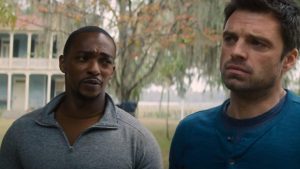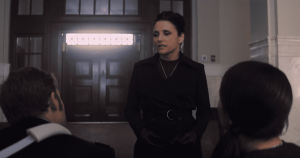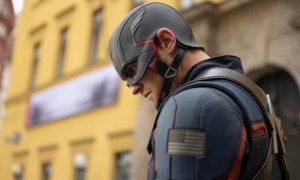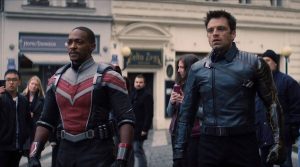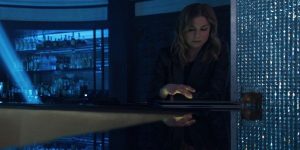SPOILERS FOR THE FALCON AND THE WINTER SOLDIER AHEAD!
Ralph Bohner walked, so Contessa Valentina Allegra de Fontaine could…also walk, but in really fancy high-heeled boots that even she admitted were incredibly uncomfortable.
There was a time, at the height of WandaVision‘s popularity, that it didn’t seem so inconceivable that any number of celebrity cameos might populate the series’ later episodes, giving rise to countless theories each more outlandish than the last. First it was Evan Peters as Peter Maximoff, then suddenly the entire X-Men universe was going to spill over into Westview by means of the Multiverse, including Ian McKellen as Magneto, Patrick Stewart as Professor X, and Hugh Jackman as Wolverine. Then it was Tobey Maguire as Spider-Man, for reasons still unbeknownst to me. Somewhere along the line, fans decided a throwaway reference to an “aerospace engineer” was actually a nod to Mr. Fantastic or Blue Marvel. Al Pacino as Mephisto was a topic of serious debate.

And in the end, the big cameos that WandaVision teased turned out to either be misdirects or literal pranks by the cast. Evan Peters wasn’t even playing Peter Maximoff: he was just a random guy named Ralph Bohner, and the fact that he played the X-Men universe’s version of the character whose personality he assumed in Westview was a coincidence. But therein lies the danger of theorizing – it’s incredibly fun, particularly in comic-book franchises where there are no shortage of rabbit holes to dive down, but you shouldn’t let it interfere with your ability to enjoy a story that turns out to be doing something completely different than what you theorized.
At the same time, I do think filmmakers and showrunners could perhaps refrain from overhyping literally every reveal, as seemed to sometimes be the case with WandaVision, if only to protect their own projects from inevitable fan backlash. But caving in to the most absurd fan theories is also a bad idea: how much further afield would The Falcon And The Winter Soldier have drifted in its middle section if it had had to stop and introduce Wolverine in Madripoor?
All of that is to say: Julia Louis-Dreyfus popping up in The Falcon And The Winter Soldier as an iconic character from Marvel Comics was the perfect kind of surprise, because, while it’s quite a brief cameo, and doesn’t distract a bit from the main narrative, it’s also fun, unpredictable (while still making sense in hindsight, like any good twist), and allows us to do some rabbit-hole diving right now, as we discuss the past, present, and future, of Contessa Valentina Allegra de Fontaine (no, I will not abbreviate it to Val: Contessa Valentina Allegra de Fontaine literally says in the episode never to do that, and my SEO optimization says to pad my posts with at least 600 words).
Formally known as La Contessa Valentina Allegra de la Fontaine, the character first appeared in the Nick Fury: Agent Of S.H.I.E.L.D. comics in the late 1960’s, with her backstory mostly shrouded in mystery, but generally giving the impression that she was a fabulously wealthy Italian heiress until her parents were killed, at which point her skills as a hand-to-hand fighter and sharpshooter caught the eye of S.H.I.E.L.D., and she was recruited into the organization as Agent 14. Appointed leader of the all-women S.H.I.E.L.D. team “Femme Force”, Contessa Valentina Allegra de Fontaine’s working relationship with Nick Fury quickly became a romantic one – so romantic, in fact, the Comics Code Authority intervened.
More recently, La Contessa has played a major role in the Secret Invasion storyline, being the victim of a Skrull impersonator. While laying low in Britain, she worked alongside Lance Hunter, who has already appeared in the MCU-adjacent Agents Of S.H.I.E.L.D. TV series. And then her entire backstory was retconned, and she was revealed to be a Russian sleeper agent working with the organization known as Leviathan to infiltrate HYDRA, leading to her taking over the title of Madame Hydra.

In the MCU, all we know about her comes from her exceedingly brief interaction with John Walker, during which she tells him to keep in touch with her as he might prove “very, very valuable to certain people”. Although she never states her true purpose, her knowledge of classified state secrets suggests a connection to either S.H.I.E.L.D. or HYDRA – and her threatening aura (plus the villainous purple highlights in her hair, an upgrade from her Bride of Frankenstein-esque white streak in the comics) makes the latter more likely. We also know from Vanity Fair that Julia Louis-Dreyfus was originally supposed to debut in Black Widow, most likely in a post-credits scene.
That, coupled with the handful of hints she drops, have led many to believe she’ll be assembling the MCU’s Thunderbolts (a team of reformed villains from the comics) or Dark Avengers (a team of evil doppelgangers of the original Avengers), jumping from films to Disney+ shows and back to recruit all the best baddies onto her team before they can be killed or imprisoned. She just missed her opportunity to accost Baron Zemo (the original founder of the Thunderbolts in the comics), but the fact that he’s currently on his way to The Raft rather than Wakanda makes it easier for La Contessa to potentially break him out. And if she does appear in Black Widow, that’ll probably be where she picks up Natasha Romanoff’s younger sister, Yelena Belova.
Since she’s clearly being set up as a puppet-master of sorts, she may also be tied to the Power-Broker of Madripoor – and there’s a possibility they’re one and the same. That honestly makes more sense than Sharon Carter being the Power-Broker herself, since she doesn’t seem to have much motive to design an army of Super-Soldiers. But Carter could be working for La Contessa, something that would parallel the characters’ dynamic in the comics, where Carter was a Femme Force member and the two were rivals for the team’s leadership position.
It’s also important to note that even if Contessa Valentina Allegra de Fontaine is affiliated with HYDRA, and even if she does call herself Madame Hydra, that doesn’t somehow retcon Agents Of S.H.I.E.L.D.‘s version of Madame Hydra out of existence, as some people are claiming. S.H.I.E.L.D.‘s Madame Hydra is a character from the HYDRA-operated Framework simulation, not even a real person, and her character design was lifted from Ophelia Sarkissian, another woman who wears the title in the comics. Haters love to claim Agents Of S.H.I.E.L.D. isn’t MCU canon, but it still lives rent-free in their heads.

There also remains the slight chance that La Contessa isn’t a straight-up villain. A lot of S.H.I.E.L.D. agents are just…kind of shady, particularly those in Nick Fury’s inner circle. I think this is least likely out of all the options, but if it means we get to see Samuel L. Jackson and Julia Louis-Dreyfus flirting all the way through the Secret Invasion series, I’d be okay with keeping her on S.H.I.E.L.D.’s side for a little while. Though it would be even more entertaining if they’re bitter exes on opposite sides of a conflict between their teams, whose romantic history allows them to predict their insignificant other’s next moves.
So what do you think Contessa Valentina Allegra de Fontaine is plotting? Which team of villains should she be assembling, and why? Share your own thoughts, theories, and opinions, in the comments below!

